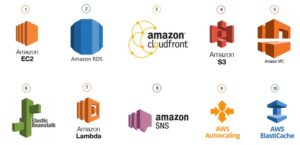Introduction
As cloud computing continues to revolutionize the IT industry, Amazon Web Services (AWS) remains at the forefront, offering a vast array of services to meet the evolving needs of businesses worldwide. In 2024, AWS will continue to dominate the cloud market, providing a comprehensive suite of services designed to drive innovation, scalability, and efficiency.
This blog will explore the top 10 most used AWS services, highlighting their importance in cloud computing.
Dive deeper into the world of cloud technology and IT mastery with IPSpecialist! Get the best course by accessing comprehensive IT certification training and resources. From beginner-level IT courses to mastering Cloud Computing, Cybersecurity, DevOps, Microsoft, and more, IPSpecialist offers diverse courses, study guides, and practice exams tailored to amplify your skills.

The Top 10 Most Used AWS Services
AWS provides many offerings; however, positive ones are critical for numerous programs. Let’s delve into the top 10 maximum used AWS services.
-
Amazon EC2 (Elastic Compute Cloud)
Amazon EC2 is an essential constructing block of AWS Services, presenting scalable and resizable compute capacity inside the cloud. It gives digital servers (instances) that may be quickly provisioned and configured to host packages with varying workloads. AWS EC2 instances are customizable, allowing users to select the favored CPU, reminiscence, storage, and networking capacity. This flexibility makes EC2 perfect for various use instances, from the website hosting easy internet packages to going for walks with complex, facts-in-depth workloads.
Use Cases:
- Hosting websites and web applications
- Running backend services and APIs
- Batch processing and data analysis
- Development and testing environments
-
Amazon RDS (Relational Database Service)
Amazon RDS is a wholly controlled relational database provider that simplifies database administration responsibilities with setup, patching, and backups. It supports multiple database engines, including MySQL, PostgreSQL, Oracle, and Microsoft SQL Server. RDS is designed to automate routine database tasks, permitting developers to focus on application improvement instead of database management. It presents excessive availability, automatic backups, and smooth scalability, making it a handy desire for organizations requiring a robust and scalable relational database answer.
Use Cases:
- Hosting web applications with relational databases (e.g., WordPress, Magento)
- Storing transactional data for e-commerce platforms
- Managing customer databases for CRM systems
- Running business intelligence and reporting applications
-
Amazon S3 (Simple Storage Service)
Amazon S3 is a scalable and sturdy object storage service designed for storing and retrieving any quantity of records at any time. It is a foundational component for diverse AWS offerings and is typically used for information storage, backup, and archiving. AWS S3 is characterized by its simplicity, scalability, and coffee-latency to get admission to saved records. It supports capabilities like versioning, access manage, and occasion notifications, making it a flexible solution for coping with various facts storage desires.
Use Cases:
- Storing and serving static website content
- Hosting media files (images, videos, etc.)
- Backup and archival of data
- Data lakes and big data analytics
-
Amazon CloudFront
Amazon CloudFront is a Content Delivery Network (CDN) provider that hastens the transport of internet content material to customers internationally. CloudFront reduces latency by dispensing content material throughout a worldwide community of edge places and complements the consumer experience. It can be integrated with different AWS offerings, including S3 and EC2, to supply static and dynamic content material efficiently. CloudFront additionally affords protection features, which include DDoS protection and SSL/TLS encryption, ensuring a secure and reliable content shipping infrastructure.
Use Cases:
- Accelerate website loading times by delivering content from nearby edge locations worldwide.
- Enable global software updates with rapid downloads, enhancing user experience and efficiency.
- Optimize video delivery for seamless playback in both on-demand and live-streaming scenarios.
- Ensure seamless video playback by optimizing delivery for on-demand and live-streaming content.
-
Amazon VPC (Virtual Private Cloud)
Amazon VPC allows users to safely connect AWS sources and make more extensive on-premises networks into the AWS cloud. It gives a logically remoted segment of the AWS cloud where customers can define their community configuration, consisting of IP cope with stages, subnets, and routing tables. VPC gives control over community protection, allowing users to configure firewalls and create non-public subnets. This degree of customization makes Amazon VPC an essential carrier for building a secure and flexible community infrastructure within the cloud.
Use Cases:
- Hosting multi-tier applications with private and public subnets
- Securely connecting on-premises data centers to AWS
- Implementing network isolation and segmentation for compliance requirements
- Building hybrid cloud architectures with VPN and Direct Connect
-
Amazon SNS (Simple Notification Service)
Amazon SNS is a controlled messaging service that helps send messages to a distributed set of recipients. It supports multiple conversation protocols: HTTP, HTTPS, email, and SMS. SNS simplifies the technique of sending messages, notifications, and signals, making it a valuable device for constructing scalable and decoupled architectures. With SNS, developers can easily broadcast messages to many subscribers, enhancing conversation efficiency in disbursed structures.
Use Cases:
- Sending real-time notifications to mobile devices (iOS, Android)
- Triggering automated workflows and alerts based on system events
- Broadcasting messages to subscribers via email, SMS, or HTTP endpoints
- Integrating with other AWS services for event-driven architectures
-
AWS Elastic Beanstalk
AWS Elastic Beanstalk is a Platform-as-a-Service (PaaS) imparting that simplifies the deployment and control of applications. It supports multiple programming languages and frameworks, allowing builders to be mindful of writing code without demanding approximately the underlying infrastructure. Elastic Beanstalk handles application deployment, potential provisioning, load balancing, and car-scaling, streamlining the improvement and operational procedures. This makes it an excellent preference for agencies seeking a platform that combines flexibility simply of use.
Use Cases:
- Quickly deploy web applications without managing infrastructure
- Automatically scale resources based on demand for optimal performance
- Easily manage deployments, monitoring, and logging in one place
- Deploy complex applications with frontend, backend, and database components effortlessly
-
AWS Lambda
AWS Lambda is a serverless computing carrier that enables the execution of code in reaction to occasions without the want for server provisioning. Developers can upload code snippets (features) to Lambda, and the carrier routinely takes care of scaling, monitoring, and preserving the infrastructure required for execution. Lambda is event-pushed and supports integration with diverse AWS offerings, making it a powerful tool for building scalable and fee-powerful applications that respond dynamically to changes in workload.
Use Cases:
- Event-driven application architectures (e.g., processing S3 events, DynamoDB streams)
- Real-time data processing and analytics
- Microservices and serverless API backends
- Scheduled tasks and cron jobs
-
AWS Autoscaling
AWS Autoscaling is a provider that robotically adjusts the number of EC2 times based on defined regulations or adjustments in demand. It maintains software performance and optimizes value by dynamically adjusting resources to shape the contemporary workload. Autoscaling may be configured to scale horizontally (adding extra times) and vertically (adjusting the ability of current times), providing a flexible and automatic solution for managing varying stages of traffic and demand.
Use Cases:
- Dynamically adjust server capacity to match changing traffic loads, ensuring optimal performance.
- Automatically replace failed instances to maintain application availability and reliability.
- Scale resources up or down as needed, minimizing costs while meeting performance requirements.
- Plan for predictable traffic changes by scheduling capacity adjustments ahead of time
-
AWS IAM (Identity and Access Management)
AWS IAM is a centralized service for securely handling entry to AWS sources. It permits agencies to define and manipulate who can get admission to particular assets and what moves they could perform. IAM provides a granular level of manipulation over consumer permissions, roles, and rules, allowing corporations to adhere to the precept of least privilege. By managing identities and getting entry, IAM enhances the security posture of AWS environments and ensures that the best legal individuals or structures can interact with sources.
Use Cases:
- Manage user access to AWS services and resources with fine-grained permissions.
- Assign roles with specific permissions to users and services, ensuring secure and least privileged access.
- Centrally manage access across multiple AWS accounts by creating cross-account roles.
- Securely grant access to AWS services like S3 and EC2 by attaching IAM policies to users and roles.
AWS Services Usage Trends in 2024
Continued Growth in Core Services:
- Scalability and Cost-efficiency: Demand for core AWS services like EC2 compute instances, S3 storage, and Lambda serverless functions is expected to rise due to their inherent scalability and cost-effectiveness.
Focus on Emerging Technologies:
- Machine Learning (ML): Services like Amazon SageMaker and Amazon SageMaker Edge will increase adoption as businesses leverage AI and ML for tasks like data analysis, product development, and personalized customer experiences.
- Generative AI: With the introduction of services like Amazon Bedrock and Amazon Q, businesses are expected to increasingly utilize cloud-based solutions for training and deploying powerful generative AI models.
- Internet of Things (IoT) and Blockchain: Services like AWS IoT Greengrass and Amazon Quantum Ledger Database will likely gain traction as businesses look to manage and secure data from a growing network of connected devices and explore blockchain applications.
Industry-Specific Solutions:
- Manufacturing: Cloud solutions for product lifecycle management (PLM) on AWS are expected to be in high demand, enabling manufacturers to improve efficiency, collaboration, and product quality.
Skilling and Talent Acquisition:
As cloud adoption continues, the demand for skilled professionals with expertise in AWS services is expected to surge. This will focus on training and development initiatives to bridge the talent gap.
Conclusion
In closing, the top 10 most used AWS services we’ve discussed are the bedrock of cloud computing and app development. AWS covers a broad spectrum of needs, from scalable computing power with EC2 to fully managed databases via RDS. Essential services like S3 for storage, VPC for security, and IAM for access management highlight AWS’s commitment to robust and secure cloud solutions. Additionally, services like Lambda and Autoscaling point to serverless and automated infrastructure trends, streamlining app deployment and cutting costs. These services empower businesses to innovate and grow in today’s digital landscape.
Get started today and revolutionize your business using AWS Cloud Service!
FAQs
-
What is AWS, and what services does it offer?
AWS is Amazon’s cloud computing platform, offering computing power, storage, databases, machine learning, analytics, and networking services.
-
How can AWS help businesses and organizations?
AWS provides scalability, cost-effectiveness, reliability, security, and flexibility, enabling businesses to innovate and grow without heavy upfront investments.
-
What are the pricing models for AWS services?
AWS offers On-Demand, Reserved, Spot Instances, Savings Plans, and free tiers, allowing users to choose pricing based on their usage needs.








